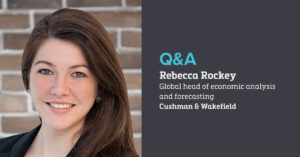Managing commercial real estate deals and data has always been difficult. The essential details about a borrower and a property that are needed to complete a commercial mortgage request hasn’t changed much. Tools to manage this mountain of information, however, have been advancing.
Today, several innovative apps and platforms go far beyond the capabilities of spreadsheets, making it far easier to find new clients and track the progress of deals from the first contact with the client to the loan closing. As a mortgage broker, however, you have some choices about what system to use and it is important to choose wisely. Your deal-management database can be the lifeblood of your brokerage. It typically contains everything you know about past and prospective clients, their properties and the status of every deal in your pipeline.
The potential uses of a deal-management system run the gamut of the business. The commercial mortgage broker will use it to prospect for new clients, to prioritize daily tasks and to keep track of numerous complicated deals that may take months to close.
Customer relationship management (CRM) software systems differ in features and capabilities, however, and vary tremendously in cost. Given that today’s commercial mortgage market is generally thought to be in a transitional period in which bottom-line costs need to be controlled, it is a good time for you to step back and evaluate your system.
The overall upfront cost to purchase software is typically more than the upfront cost to lease, but the savings are significant over the long term.
To lease or buy
There are two general models available today. You can either lease deal-management software or buy it. Today, leasing is by far the more common option. Typically, you will pay a monthly or annual fee that depends on the suite of options that you choose.
These tools are often operated through a large CRM base platform, such as Salesforce or Zoho. These are generic platforms used by several different industries for sales and marketing. For an additional cost, each subscriber can customize their system based on their business needs. The leasing option usually eliminates the need for any internal technical support or training. Subscription providers employ a staff to assist the customer with training and support.
The annual cost to lease your system, however, can add up quickly. It ranges from $59 per month to well over $100 per month, depending on what options and support services you select. On top of the base cost, add-on features can cost up to thousands of dollars per month for larger company commitments. Under the leasing model, a company is typically charged per user license. Without add-ons, the average published subscription fee is about $75 per user per month. A leasing contract for a company with 50 users would therefore cost $45,000 per year.
Another downside of leasing is that the contract usually can’t be cancelled early to cut expenses, if you are reducing staff or there is a downturn in the market. Although leasing is the preferred method today, it wasn’t always that way. Commercial mortgage brokers and real estate brokers once commonly developed and owned their own deal-management software. This purchase model, however, all but disappeared with the arrival of the internet and the cloud.
One problem with early deal-management software programs was that the vital property and client details within internal databases couldn’t be easily shared among many offices. With the development of internet-based CRM platforms, leasing became the standard model. Today, owning a CRM deal- management solution has been virtually nonexistent in the open marketplace.
Controlling costs
The market is changing again, however, and it is now possible to buy and customize your own software. One of the advantages of owning your own system is the cost. You purchase the software for a one-time fee, which will amount to far less than leasing the product over a long run.
There are some hurdles to overcome when you buy a system. One downside in buying the software is that your company will typically need to do internal technical support and training. The tech support also can be outsourced to the software publisher as part of the maintenance agreement. This agreement also would ensure that the software remains current with new releases, upgrades and product enhancements.
The cost of the one-time base fee will depend on the number of users, but it averages about $1,000 per user. The hosting fees are separate and can vary. Some brokerages can host the software on their own servers, but there also are options to pay an annual hosting fee to a third party, such as Microsoft or Amazon. Typically, these are paid by bandwidth used or allotted, and range from $50 per month and up. Mapping and file-management components are usually part of the out-of-the box software package. Other add-on solutions like document signing and e-mail or marketing canvassing typically remain subscription based.
The overall upfront cost to purchase software is typically more than the upfront cost to lease, but the savings are significant over the long term. In a scenario where there are 50 users, for example, the base cost will be about $50,000 to purchase the software. Annual hosting and licensing fees are estimated to be $1,200. Maintenance-agreement fees typically cost 15% of the base price of the software per year. Over five years, the overall cost, including the initial $50,000 investment with the $1,200 yearly hosting fee and a $7,500 annual maintenance fee, will be $93,500. By contrast, the leasing route will cost about $45,000 per year or $225,000 over five years.
Both models offer a similar customer experience. All modern deal-management software systems, whether leased or owned, are designed to be user-friendly, enabling the client to easily enter or import the property and client details.
Once the information is entered into the system, it becomes easily searchable. In researching a property, for example, a user could typically find the complete ownership history, any asset sales and associated companies. Aside from being a natural marketing and prospecting tool, this software also can be used to track the entire sequence of a deal from the initial contact with a client to the closing. And you can assign a probability that a deal will close, which is useful in ordering your daily priorities. The information is easily shareable among many parties regardless of whether you own the software or lease it through a CRM platform.
The bottom line is that commercial mortgage brokers now have a choice. Whether you ultimately choose to buy or lease your deal-management software, it is important to shop around to gauge your needs. The option to buy your system is a way for commercial mortgage companies to control costs in what could soon become leaner times.
Author
-
Rick Peltz is the founder of Industrial Science Renaissance, a Rancho Mirage, California-based consulting and software provider specializing in commercial brokerage services and solutions. Peltz has broad industry experience with more than 30 years of direct support or consultation in commercial real estate, banking, public utilities and financial services. Reach Peltz at rp@indsr.com or visit industrialsciencerenaissance.com.





